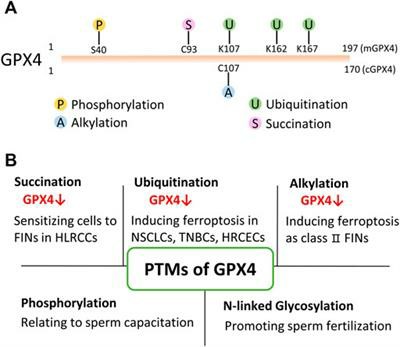What is GPX4 Protein
GPX4 protein is a member of the glutathione peroxidase family, enzymes renowned for their antioxidant properties. The GPX4 enzyme, predominately selenium-dependent, is encoded by the GPX4 gene present in humans. Its discovery sheds light on our comprehension of how cells deal with oxidative stress, a prevalent phenomenon that interrupts regular cellular activities.
The GPX4 gene is located on the 19th chromosome at the locus 19p13.3 in humans, encapsulating a region of approximately 63k base pairs. The protein structure of GPX4 is unique - a monomer that exists in two isoforms. Isoform one, the longer version, comprises 197 amino acids, while isoform two, a shorter version, includs 170 amino acids. These varying structural conformations serve different physiological roles and are subject to differential expression patterns across various tissues.

Fig1. PTMs of GPX4 (Cui, C., et al, 2022)
Function of GPX4 Protein
The principal role of GPX4 majorly orbits around its antioxidant prowess. It facilitates the reduction of harmful lipid hydroperoxides to their respective alcohols and reduces free hydrogen peroxide to water, keeping the onslaught of oxidative stress at bay. It is also involved in the creation of eicosanoids as part of the inflammatory response and aids in sperm maturation. Its ubiquitous distribution in almost all tissues highlights the importance of GPX4 in cellular homeostasis.
GPX4 Protein Related Signal Pathway
GPX4 protein plays an integral part in the ferroptosis process, a type of programed cell death independent of caspases associated with iron-dependent lipid peroxide accumulation. Rarely does one protein influence an entire pathway, but GPX4 is one of the rare exceptions. It is the primary regulator of ferroptosis resistance, as it neutralizes lipid peroxides and prevents the death signal. Inhibition of GPX4 can evoke ferroptotic cell death, making GPX4 the crux of the ferroptosis signaling pathway.
GPX4 Protein Related Diseases
The importance of GPX4 protein extends to disease pathology, with evidence linking it to various conditions. Anomalies in GPX4 activity have been implicated with neurodegenerative diseases such as Alzheimer's and Parkinson's. Additionally, a deficiency in GPX4 has been associated with male infertility, owing to its pivotal involvement in sperm maturation.
Our understanding of the role GPX4 in ferroptosis opened a new vista in cancer biology. Cancer cells often show upregulated GPX4 expression, promoting resistance to ferroptotic death. Hence, GPX4 inhibitors have been suggested as potential therapeutic interventions for combating cancer's resistance mechanisms.
GPX4 Protein's Applications in Biomedical
Understanding GPX4's biology has fostered its application in biomedical research. The potential role of GPX4 as a unique therapeutic target for neurodegenerative diseases and cancer aids the design of tailored interventions.
Within the realm of drug design, novel GPX4 inhibitors are being developed, aiming at the euphoria of killing cancer cells. In the realm of genetic engineering, using CRISPR technology, altering GPX4 expression in cell lines has unraveled its role in ferroptosis, providing extensive scope for biomedical research.
In conclusion, the GPX4 protein, akin to a multitasking jester, is not only an antioxidant stalwart but also reigns in the signaling pathway of ferroptosis. Consequently, it governs an array of cellular responses, placing it centrally in our understanding of disease pathology. Its extensive implications in various pathological conditions combined with its biomedical applications underscore the need to deepen our knowledge about this fascinating protein. Through continued research efforts, the GPX4 protein may become the cornerstone for several therapeutic interventions in the future.
Our Featured Products
| Cat.No. | Product Name | Species | Source (Host) | Tag |
|---|---|---|---|---|
| GPX4-13510H | Recombinant Human GPX4, GST-tagged | Human | E.coli | GST |
| GPX4-29080TH | Recombinant Human GPX4 Protein | Human | E.coli | N/A |
| GPX4-8203H | Recombinant Human GPX4 protein, His & GST-tagged | Human | E.coli | His/GST |
| GPX4-29076TH | Recombinant Human GPX4, His-tagged | Human | E.coli | His |
| GPX4-1894H | Recombinant Human GPX4 Protein, N-His-tagged | Human | E.coli | N-His |
| GPX4-1895H | Recombinant Human GPX4 Protein, Flag-tagged | Human | E.coli | Flag |
Reference
- Cui, C., Yang, F., & Li, Q. (2022). Post-Translational Modification of GPX4 is a Promising Target for Treating Ferroptosis-Related Diseases. Frontiers in Molecular Biosciences, 9, 901565. https://doi.org/10.3389/fmolb.2022.901565

